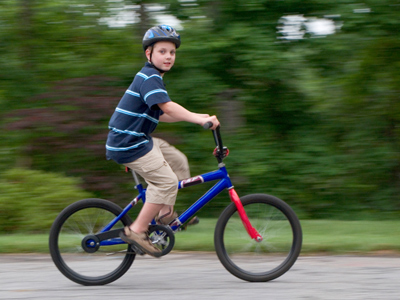
Ask the AI Tutor
Need help with Time (Year 6)? Ask our AI Tutor!
AI Tutor - Lucy
Connecting with Tutor...
Please wait while we establish connection

It would take 30 minutes to cycle 2 miles.
Time (Year 6)
In KS2 Maths, pupils explore how to read, measure, and calculate time accurately using hours, minutes, seconds, and even 24-hour clocks for real-life applications.
1 .
Tokyo is 9 hours ahead of Greenwich Mean Time. If it is 15:20 in London what time is it in Tokyo?
00:20
1:20
9:20
10:20
15 + 9 = 24 but 24:00 is displayed as 00:00 on a 24 hour clock
2 .
What time on an analogue clock is 19:40?
Twenty minutes to 9
Twenty minutes to 7
Twenty minutes to 8
Twenty minutes to 6
To work out the hour on a 24 hour clock just count on from 12
3 .
Which unit of time would you use to measure how long it takes for an acorn to grow into a large tree?
Hours
Months
Years
Millennia
Most oak trees live to be about 200 years old
4 .
How would five to one in the afternoon be displayed on a digital clock?
00:55
12:55
13:05
13:55
00:55 would be five to one in the morning
5 .
How long would it take to cycle 2 miles?
30 seconds
30 minutes
30 hours
30 weeks
That's a slow and relaxed pace - but 30 hours would be a crawl and 30 seconds would be as fast as a racing car!
6 .
What is equivalent to 10 years?
Week
Century
Decade
Millennium
Each group of 10 years is also called a decade, for example: 1960s, 1970s, 1980s, 1990s, 2000s, 2010s...
7 .
What is 1,000 years?
Millennium
Century
Decade
Week
We are living in the 3rd Millennium CE
8 .
New York is five hours behind Greenwich Mean Time. If it is 5:00 PM in London what time is it in New York?
10:00 AM
12:00 PM
2:00 PM
4:00 PM
Greenwich is in London so the time for all of Britain is the same as Greenwich Mean Time
9 .
How many days in December?
28 days
29 days
30 days
31 days
30 days hath September, April, June and November; all the rest have 31, except February alone
10 .
What is the extra date we have during a leap year?
31st January
29th February
30th February
31st December
Even with this extra day, February is still the shortest month
**Unlimited Quizzes Await You! 🚀**
Hey there, quiz champ! 🌟 You've already tackled today's free questions.
Ready for more?
Ready for more?
🔓 Unlock UNLIMITED Quizzes and challenge yourself every day. But that's
not all...
not all...
🔥 As a Subscriber you can join our thrilling "Daily Streak" against other
quizzers. Try to win a coveted spot on our Hall of Fame Page.
quizzers. Try to win a coveted spot on our Hall of Fame Page.
Don't miss out! Join us now and keep the fun rolling. 🎉
**Unlimited Quizzes Await You! 🚀**
Hey there, quiz champ! 🌟 You've already tackled today's free questions. Ready for more?
🔓 Unlock UNLIMITED Quizzes and challenge yourself every day. But that's not all...
🔥 As a Subscriber you can join our thrilling "Daily Streak" against other quizzers. Try to win a coveted spot on our Hall of Fame Page.
Don't miss out! Join us now and keep the fun rolling. 🎉






